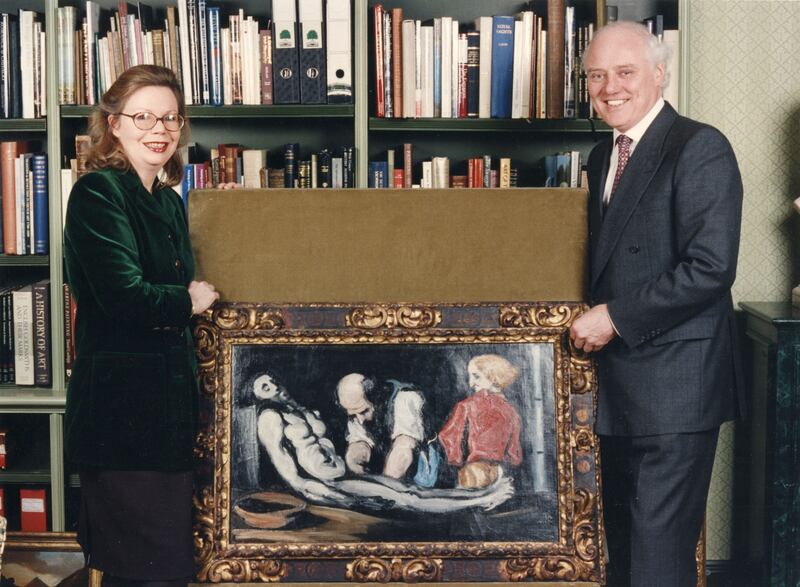Born June 1st, 1942
Died February 2nd, 2024
Writing in this newspaper in 1990 of the show then exhibiting at the Royal Hibernian Academy (RHA), A Free Spirit: Irish Art 1860-1960, the former Irish Times art critic Brian Fallon said it marked “a new beginning for Irish art ... making English people – and Irish people too – recognise the oft-ignored fact that Ireland has an art tradition in its own right”.
The exhibition was organised by the joint owners of the Pyms Gallery in London, the husband-and-wife team of Alan and Mary (nee McKenna) Hobart, who had by then played a crucial role in raising awareness of the artistic achievements of Ireland, both in this country and internationally.
Alan Hobart, originally from Devonshire, died in 2021, and in February, Mary died aged 81.
Mary was born into a family of farmers and shopkeepers in Co Monaghan in 1942. She was one of a number of children of Michael and Alice (nee Boyle) McKenna, of Drumbeer, Scotstown, Co Monaghan. The family emigrated to London in 1950. It was a propitious time; her niece, Lara Daly, recently described her aunt as “an inherently artistic and creative person ... with an instinctive eye” and recalled being told how she was fascinated by the Festival of Britain in 1951. She was educated at the Convent of St Aloysius, Camden Town. She kept in touch throughout her life with a wide circle of her relatives both in London and in her native Scotstown.
The Hobarts’ life journey in bringing the Irish art of the late 19th and 20th centuries, and of more recent Irish artists such as Rita Duffy and Hector McDonnell, from obscurity to renown was a success.

Neither of the Hobarts had had any formal training either as artists or as art historians when they set up Pyms in 1975 on the Brompton Road. The firm later moved to Motcomb Street, and finally to a premises on Mount Street in a fashionable part of Mayfair.
They shared a Catholic faith and a passion for Irish art. What they lacked initially in expertise they more than made up for in keen interest, private study and the relentless seeking out at auctions the length and breadth of Britain and Ireland overlooked paintings and sculpture. Even in the 1970s, Irish art was still regarded as being on the fringe of the mainstream.
“The Irish in the early 20th century had been poets and playwrights, not painters. The Hobarts set out to disprove this popular misconception,” The Irish Times wrote in Alan Hobart’s 2021 obituary.
William Orpen might be described as their first specialisation in the subject. From 1980, and William Orpen, 1876-1931, Early Work, they went on to buy and sell hundreds of his works, including On the Beach, Howth (1910) and A Summer Afternoon from the same year. In 1996 they set up the Orpen Research Fund to further enhance knowledge of the artist’s work.
Throughout the 1980s and 1990s they brought work by the greatest Irish artists to London and international buyers. At a show called The Irish Revival (1982), they exhibited works by John Lavery, John Luke, Walter Osborne, Paul Henry, Jack B Yeats and Louis Le Brocquy.

In 1985 they held a show called Celtic Splendour – a title later characterised by art historian William Laffan as “provocatively assertive”.
Later that same year their exhibition Irish Renascence: Irish Art in a Century of Change featured work by artists including Norah McGuinness, Nano Reid, Mainie Jellett, Roderic O’Conor and Charles Lamb, among others. Of particular significance was their championing, from as early as 1986, of the art of Mary Swanzy, one of the most original of Irish modern artists, after they had been approached to represent her estate by Mary St Clair Swanzy Tullo, the artist’s niece.
Swanzy, whose work was shown in exhibitions in 1986, 1989 and 1998, brought to a completely new generation of collectors an awareness of a treasure trove previously largely hidden away in her studio for decades.
Mary Hobart and her husband brought to their art dealing a notable perspicacity, thorough research and intuitive commercial instinct. A notable example was their purchase in 1996 of one of the versions of Edvard Munch’s Girls on a Bridge for $7.7 million, which they sold on a few years later for $30.8 million.
Mary and Alan Hobart had no children. She is survived by siblings and a wide family.




